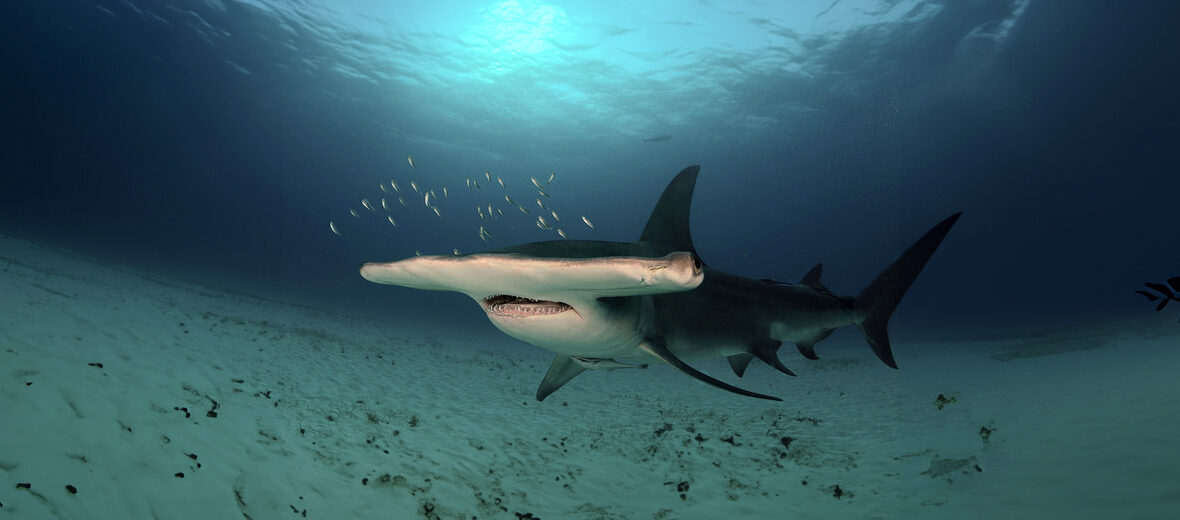
The great hammerhead is the largest known species of hammerhead shark. They are found in tropical and warmer temperate waters throughout the world. These hammerheads are caught globally as bycatch and targets in commercial and small-scale gillnet, pelagic longline, and purse seine fisheries. Due to their large fins, they are also often stripped of said appendages for shark fin soup and then cast back into the ocean to die a slow, painful death. As a result of this overfishing and horrible finning practice, as well as a decreasing population, the IUCN lists these sharks as Critically Endangered.
First the Stats…
Scientific name: Sphyrna mokarran
Weight: Up to 991 lbs.
Length: Up to 20 feet
Lifespan: Up to 44 years
Now on to the Facts!
1.) These sharks can be told apart from other hammerheads by their cephalofoil (hammer) which is wide with a nearly straight front margin, by their tall, and sickle-shaped first dorsal fin.
2.) Even though they are potentially dangerous creatures, bites to humans rarely occur. Rather, they are quite curious of divers. That being said, they are also known for being the most aggressive of all hammerheads.
3.) They prey on crustaceans, cephalopods, bony fish, smaller sharks, and their favorite prey item stingrays.
4.) Observations have suggested that their cephalofoil is actually utilized to stun and immobilize stingrays. They attack the ray from above, then pin it to the substrate and bit off chunks of each of the ray’s fins.
5.) These sharks were first described as Zygaena mokarran in 1837 by German naturalist Eduard Rüppell. The species name is the common name in Arabic مقرن and translates to “horned”. The name was later changed to the current Sphyrna mokarran.
But wait, there’s more on the great hammerhead!
6.) While favoring coral reefs, they also inhabit continental shelves, island terraces, lagoons, and deep water trenches near land.
7.) Females are viviparous (give live birth), and undergo up to an 11 month gestation (pregnancy) that yields up to 50 pups!
Did you know…?
If cornered they will respond with an agonistic display, dropping their pectoral fins and swimming in a stiff and/or jerky fashion. If continued to be harassed they can and will attack.
8.) A female will give birth about ever 2 years.
9.) The great hammerhead is a solitary and nomadic predator that is usually given a wide berth by other reef sharks.
10.) Juveniles are preyed on by bull sharks, while the only natural predator of adults is the mighty orca.
But wait, there’s still more on the great hammerhead!
11.) Yellow jacks (a type of tuna) have been seen rubbing themselves against the hammerhead’s rough flanks, to potentially rid themselves of parasites.
12.) Various species of copepods parasitize great hammerheads, like Alebion carchariae, A. elegans, Nesippus orientalis, N. crypturus, Eudactylina pollex, Kroyeria gemursa, and Nemesis atlantica. These copepods can cause injury, disease, and even blindness.
Did you know…?
The banning of shark finning by countries and supranational entities like United States, Australia, and the European Union, & international regulatory bodies like the International Commission for the Conservation of Atlantic Tunas, should hopefully reduce fishing pressures on the great hammerhead.
13.) Great hammerheads reduce drag and energy expenditure by swimming on their side in a posture coined as “rolled swimming”.
14.) Due to their large size and sharp cutting teeth, the great hammerhead can seriously injure a human, so caution should be exercised around them when diving.
15.) As of 2011, the International Shark Attack File lists 34 bites by hammerheads, with 17 of them being unprovoked yet none fatal.
16.) These, as is the case in many other shark species, are affected by climate change. Climate change can have a dramatic effect on their feeding habits, distribution, and migratory patterns.
Now a Short Great Hammerhead Video!
Be sure to share & comment below! Also, check out the Critter Science YouTube channel. Videos added regularly!
Want to suggest a critter for me to write about? Let me know here.
Some source material acquired from: Wikipedia & IUCN
Photo credit: Albert kok




